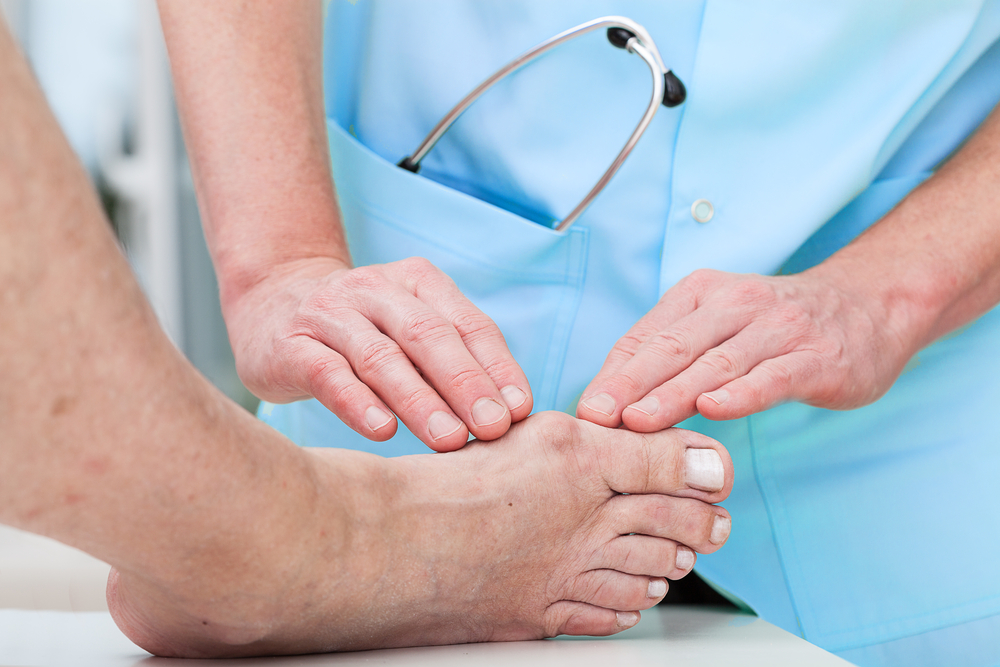Bunions, also called Hallux valgus, are often painful protrusions at the bottom of your big toe. They can cause a wide range of issues such as bursitis, hammertoe, and metatarsalgia, which is why you should contact your local Victoria, Kelowna, or Nanaimo foot specialist. But why does the problem occur in the first place, and why do so many people find that their Hallux gets worse over time?
Today, we will discuss the reasons why you have a bunion and what you can do to counteract the problem. While changing to more comfortable and spacious footwork can be a starting point, your specialist might suggest certain biomechanical interventions and surgery. Patients generally find that treatment greatly improves their quality of life, and most people never have to deal with Hallux again.
What Are Bunions?
The name Hallux valgus describes bony protrusions on the sides of the feet, often at the bottom end of the large toe. At the start, you may just notice a lump on your foot, but if you leave it untreated, it will continue to grow. Eventually, your Hallux starts to push your toes sideways, so your big toe no longer points forward but instead towards the other toes. In some cases, the skin on top of the Hallux becomes hard, swollen, or red.
The cause of this problem is not always known, and you might develop it due to genetic factors. Some people are born with it, in which case the issue is a birth defect. However, there are certain actions that increase the incidence of Hallux, which is why the condition occurs more often in people over the age of 20. Many people who regularly wear shoes that are too tight and that pinch the feet will develop this issue.
Why Do They Get Worse?
Over time, you’re likely to notice that your Hallux gets worse. This can be very distressing, particularly if you feel pain when wearing shoes or standing and walking for a long time. In most cases, the reason why you are experiencing a worsening of the condition is that you are wearing certain types of shoes that rub and chafe at the joint. These include tight, hard shoes and high heels.
Another reason why you might experience an increase in the size of your bunion is due to certain kinds of arthritis. People particularly at risk include those who have an inflammatory condition, such as rheumatoid arthritis. However, experts disagree over whether such conditions and wearing tight shoes actually cause Hallux, or whether they just make the problem worse once it has established itself.
What Are the Consequences of Hallux?
Over time, the bunion can worsen to the point of causing other issues and preventing you from taking part in many of your regular daily activities, especially if you are very active. Hallux can lead to a variety of additional conditions, a common one being bursitis. This involves the fluid-filled pads which cushion your joints becoming inflamed and painful.
In addition, Hallux can also cause hammertoe, which is an abnormal bend in your middle toe joint, usually of the second toe, so that it sticks out at the top. Hammertoe can make wearing footwork very uncomfortable, since the joint will rub against the top of the shoe. Metatarsalgia is another potential problem caused by Hallux, and it makes the ball of your foot swell up and become painful.
What Can You Do?
As you can tell, Hallux becomes a big problem if it is left to grow, so you should always take action when you see the first signs. Above all, remove the trigger, which might be a pair of shoes you’re wearing on a regular basis. Then, you can see a specialist to find out what has caused your Hallux and to get some advice about what to do next. You might need surgery, or the issue could be addressed by changing your posture and way of walking.
Wear Well-Fitting Shoes
Whether you are already suffering from bunions or not, you should always choose your shoes carefully. Rubbing and chafing should be avoided at all costs, which is why a shoe with a wide toe box is generally preferable. It’s also important to avoid buying shoes that are too small. Before making your purchase, always check that there is room between the front of your shoe and the toes.
If you have any shoes that crowd your toes, you will need to stop wearing them. Depending on the size of your Hallux, this might include footwork for formal occasions and work. In many cases, people who are experiencing foot pain feel better when wearing athletic shoes or sandals, as they will provide you with much more space and the material is softer.
See a Specialist
Whether you live in Victoria, Kelowna, or Nanaimo, you have access to one of the best foot clinics in the country. As soon as you notice an issue, take advantage of the foot specialists in your local area and book an appointment. They will have a look at your foot and potentially do some imaging studies to find out whether the problem is genetic, caused by suboptimal footwork, or due to a biomechanical issue such as misalignment or bad walking technique.
Address Biomechanical Issues
There are a variety of factors that can cause Hallux, and one of them is a problem with your posture or way of walking. In particular, pronation, which is an inwards tilt of the foot and a flattening of the arch, can contribute to the growth of the Hallux.
If this is your problem, your bunion will come back even if you get it removed surgically. In such a case, your doctor will ask you to address the underlying biomechanical issue before receiving treatment. This might be achieved through physiotherapy, certain strengthening exercises you can do at home, or orthotics that can help to retrain your body.
Get Surgery
There is no known cure for Hallux except having it removed surgically. In the past, such surgeries were complicated and painful, with a long recovery period. Fortunately, medicine has moved on, and there are now easy and minimally invasive ways to remove your bunion. In most cases, you’ll feel very little pain and have a very short recovery period after the surgery. You should speak to your doctor about this option and whether it’s appropriate for you.
Finding a Great Foot Specialist in Victoria, Kelowna, or Nanaimo
Many people have never had a problem with their feet until their Hallux appears, so they might not know what to do or where to go. Although your regular physician might be able to diagnose the bunion, visiting a specialist is best because they work with this issue every day and therefore know the most advanced methods of treatment. There are numerous Island Foot Clinics available in British Columbia, so you’re sure to find one close to your home.
Bunions can be very painful and disrupt your normal activities, and they can get worse over time if you don’t take action. Get in touch with your local foot doctor today at Island Foot Clinics in Victoria, Kelowna, or Nanaimo. Your specialist will be able to evaluate and tell you more about your condition then they will help you figure out whether surgery or other corrective measures are appropriate.

